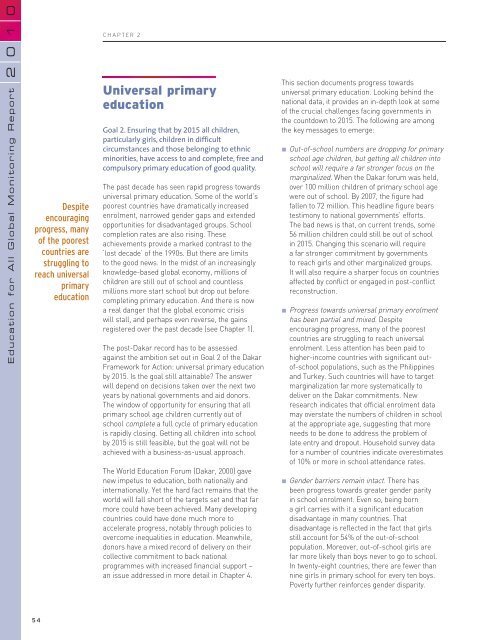Chapter 2. Progress towards the EFA goals - Unesco
Chapter 2. Progress towards the EFA goals - Unesco
Chapter 2. Progress towards the EFA goals - Unesco
Create successful ePaper yourself
Turn your PDF publications into a flip-book with our unique Google optimized e-Paper software.
0<br />
1<br />
2<br />
0<br />
CHAPTER 2<br />
Education for All Global Monitoring Report<br />
Despite<br />
encouraging<br />
progress, many<br />
of <strong>the</strong> poorest<br />
countries are<br />
struggling to<br />
reach universal<br />
primary<br />
education<br />
Universal primary<br />
education<br />
Goal <strong>2.</strong> Ensuring that by 2015 all children,<br />
particularly girls, children in difficult<br />
circumstances and those belonging to ethnic<br />
minorities, have access to and complete, free and<br />
compulsory primary education of good quality.<br />
The past decade has seen rapid progress <strong>towards</strong><br />
universal primary education. Some of <strong>the</strong> world’s<br />
poorest countries have dramatically increased<br />
enrolment, narrowed gender gaps and extended<br />
opportunities for disadvantaged groups. School<br />
completion rates are also rising. These<br />
achievements provide a marked contrast to <strong>the</strong><br />
‘lost decade’ of <strong>the</strong> 1990s. But <strong>the</strong>re are limits<br />
to <strong>the</strong> good news. In <strong>the</strong> midst of an increasingly<br />
knowledge-based global economy, millions of<br />
children are still out of school and countless<br />
millions more start school but drop out before<br />
completing primary education. And <strong>the</strong>re is now<br />
a real danger that <strong>the</strong> global economic crisis<br />
will stall, and perhaps even reverse, <strong>the</strong> gains<br />
registered over <strong>the</strong> past decade (see <strong>Chapter</strong> 1).<br />
The post-Dakar record has to be assessed<br />
against <strong>the</strong> ambition set out in Goal 2 of <strong>the</strong> Dakar<br />
Framework for Action: universal primary education<br />
by 2015. Is <strong>the</strong> goal still attainable? The answer<br />
will depend on decisions taken over <strong>the</strong> next two<br />
years by national governments and aid donors.<br />
The window of opportunity for ensuring that all<br />
primary school age children currently out of<br />
school complete a full cycle of primary education<br />
is rapidly closing. Getting all children into school<br />
by 2015 is still feasible, but <strong>the</strong> goal will not be<br />
achieved with a business-as-usual approach.<br />
The World Education Forum (Dakar, 2000) gave<br />
new impetus to education, both nationally and<br />
internationally. Yet <strong>the</strong> hard fact remains that <strong>the</strong><br />
world will fall short of <strong>the</strong> targets set and that far<br />
more could have been achieved. Many developing<br />
countries could have done much more to<br />
accelerate progress, notably through policies to<br />
overcome inequalities in education. Meanwhile,<br />
donors have a mixed record of delivery on <strong>the</strong>ir<br />
collective commitment to back national<br />
programmes with increased financial support –<br />
an issue addressed in more detail in <strong>Chapter</strong> 4.<br />
This section documents progress <strong>towards</strong><br />
universal primary education. Looking behind <strong>the</strong><br />
national data, it provides an in-depth look at some<br />
of <strong>the</strong> crucial challenges facing governments in<br />
<strong>the</strong> countdown to 2015. The following are among<br />
<strong>the</strong> key messages to emerge:<br />
Out-of-school numbers are dropping for primary<br />
school age children, but getting all children into<br />
school will require a far stronger focus on <strong>the</strong><br />
marginalized. When <strong>the</strong> Dakar forum was held,<br />
over 100 million children of primary school age<br />
were out of school. By 2007, <strong>the</strong> figure had<br />
fallen to 72 million. This headline figure bears<br />
testimony to national governments’ efforts.<br />
The bad news is that, on current trends, some<br />
56 million children could still be out of school<br />
in 2015. Changing this scenario will require<br />
a far stronger commitment by governments<br />
to reach girls and o<strong>the</strong>r marginalized groups.<br />
It will also require a sharper focus on countries<br />
affected by conflict or engaged in post-conflict<br />
reconstruction.<br />
<strong>Progress</strong> <strong>towards</strong> universal primary enrolment<br />
has been partial and mixed. Despite<br />
encouraging progress, many of <strong>the</strong> poorest<br />
countries are struggling to reach universal<br />
enrolment. Less attention has been paid to<br />
higher-income countries with significant outof-school<br />
populations, such as <strong>the</strong> Philippines<br />
and Turkey. Such countries will have to target<br />
marginalization far more systematically to<br />
deliver on <strong>the</strong> Dakar commitments. New<br />
research indicates that official enrolment data<br />
may overstate <strong>the</strong> numbers of children in school<br />
at <strong>the</strong> appropriate age, suggesting that more<br />
needs to be done to address <strong>the</strong> problem of<br />
late entry and dropout. Household survey data<br />
for a number of countries indicate overestimates<br />
of 10% or more in school attendance rates.<br />
Gender barriers remain intact. There has<br />
been progress <strong>towards</strong> greater gender parity<br />
in school enrolment. Even so, being born<br />
a girl carries with it a significant education<br />
disadvantage in many countries. That<br />
disadvantage is reflected in <strong>the</strong> fact that girls<br />
still account for 54% of <strong>the</strong> out-of-school<br />
population. Moreover, out-of-school girls are<br />
far more likely than boys never to go to school.<br />
In twenty-eight countries, <strong>the</strong>re are fewer than<br />
nine girls in primary school for every ten boys.<br />
Poverty fur<strong>the</strong>r reinforces gender disparity.<br />
54
















